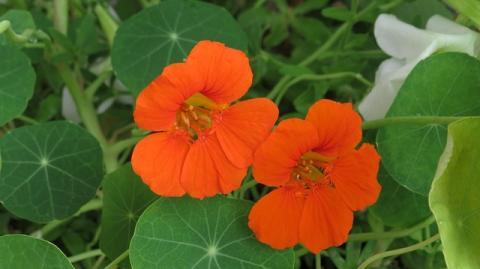
As your garden plan evolves this spring…or as you continue to sow…or at whatever stage your garden is, be sure to leave some room for a few beautiful, edible garnishes! There are dozens of edible flowers you could sow, and not only are they beautiful, but they add a vibrant pop of color to any summer dish – sweet or savory. Also, adding flowers to your garden – vegetable or not – is helpful to attract and support pollinator populations.
Most importantly, before consuming any plant or flower, be sure that you are able to properly identify it. It’s not recommended to eat flowers that you have not grown yourself – finding flowers in public places like a park or on a roadside could mean that they contain pesticides or other pollutants. Flowers from the florist are generally treated as well. If you can, use organic flowers and/or vegetable blossoms, consuming in moderate quantities and removing the pistil and stamens from the flowers (the part of the flower for pollination, which contain allergens).
*Above all, if you’re not sure what a plant/flower is, do not consume it!
Nasturtium
These bright red-orange-yellow-golden flowers definitely add an explosion of color in addition to a little spiciness similar to watercress. The flowers are easily damaged, but managed gently, can also maintain well in a bouquet. The flowers and the leaves can be eaten in salads, and also make a lovely garnish for a sweet and citrusy dessert.
Pansies
The heartsease pansy, also commonly referred to as “wild pansy,” produces smaller flowers of purplish hues with a yellow center. As the name suggests, it is believed that the heartsease pansy is a good remedy for disease of the heart in addition to epilepsy and asthma. Pansies – whole or just the petals – make a beautiful garnish for salads, or on a white-frosted cake.
Marigold
Two varieties of marigold offer different benefits for your garden: those of the tagetes genus are generally planted to repel nematodes and other insects; those of the calendula genus are used medicinally and known to have anti-inflammatory, antispasmodic and antifungal benefits. Either variety – petals only – is fine for consumption; use the petals like a pigment to bring an orangey tinge to any cooked dish.
Cornflower, or “Bachelor’s Button”
Also know as “Bachelor’s Button,” the petals of cornflowers make a nice addition to salads or fresh desserts. Generally of a bluish tint, white, purple, and pink varieties are also edible and delightful to toss on a dish.
Hollyhock
Though the fully bloomed flowers of the hollyhock can be large and cumbersome, the closed, or slightly open buds make a bold addition to any plate. They don’t have much flavor nor perfume, but can indeed be eaten.
Gladiolus
Like hollyhock, gladiolus flowers are large and rather bland tasting. They do make for a bright and showy addition to a dish, and can also be stuffed.
Bee Balm
Bees and butterflies love the bright red flowers of this plant, making it a fabulous edible pollinator plant. The individual petals taste slightly minty, and just a few go a long way.
Chrysanthemum
“Mums” generally emerge later in the season, around August to October. Like marigolds, they are also effective in ridding bugs, but the slender, modest petals also make a nice garnish for any dish, sweet or savory.
There are certainly many more edible flowers out there – lavender, hibiscus, jasmine, fuchsia, English daisy, impatiens, chamomile, lilac, rose, etc. Perhaps you already have some of these edible perennials in your garden! This summer, try planting some edible flowers!
If you’re more into getting more “bang for your buck,” or more “harvest for your labor,” kill two birds with one stone by planting vegetables that produce flowers as delectable as the vegetables themselves. Chances are, in fact, that you already plan to plant a handful of vegetables that produce tasty flowers. Some of the most common veggie flowers you might eat are:
Alliums: Chive, Garlic, Onion, Shallot, Leek
These pungent and mosquito-repelling edibles produce flowers that are globular in form, ranging from bright purples to clean white. Chive flowers are generally most versatile, and add a nice pinkish tinge of color to any fresh salad. The stem and closed garlic flower is more easily digested than the open flower.
Herbs: Basil, Dill, Cilantro, Oregano, Thyme
Not only are the leaves of these staple herbs a delightful garnish, but as the season progresses and they flower, throw the buds in a salad, pasta dish, or scramble them up with some eggs! The flowers of these herbs taste like the leaves, but milder.
Spinach & Arugula
As the nutrient-rich leaves of these plants are gradually exhausted, these two greens will shoot up some dainty flowers – either white or yellowish – which can still give you that nutrient boost in a savory dish like in a quiche or on a pizza.
Squash Blossoms
If you’re patient and attentive, perhaps you can master the art of harvesting baby squash with the [live] flower still on. Sauté these up with some butter – MUAH! Or, plucking the blossoms just before they are fully open offers a tender vessel for some melted brie or other stuffing of choice…
Pea Shoots/Flowers
After pea plants have done their vertical climbing, they’ll begin to reach out with delicate, curling tendrils. Cut these off for an artistic touch on a filet of fish or other main dish. As the flowers begin to bloom in pastel-ly pinks, select sparingly (remember, they will become your pea harvest!) to top any dish.








